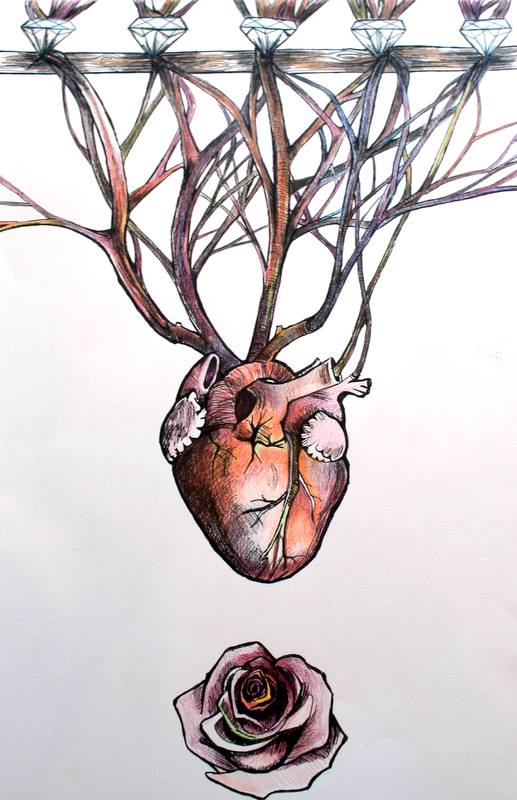By Sander Vloebergs
Hadewijch’s visions started when she was still young, young in years and young in spiritual growth. At the end of the visionary cycle she claims to have reached spiritual maturity. At this point she is capable of teaching others the mystical path. The fourteen visions that she presents were written to her friend who sought her spiritual guidance. In the first vision Hadewijch gives a general introduction to the imagery and the themes that will reappear in the remaining texts. In it she is guided by an angel through different landscapes where she sees different trees. At the end the angel shows her the way to a throne where she meets Christ who reveals to her his humanity.
It is safe to say that Hadewijch sums up an excessive amount of images, making it difficult for the visual artist to embrace all of them. For me, the text is very noisy, very intellectual because Hadewijch was explaining and interpreting all the visual stimuli herself. It was nearly impossible at that time to cancel out all the noise and the constant flood of ideas. Her own moment of divine inspiration was well hidden behind a multiplicity of allegorical imagery. The first feeling after reading this text was to tone it down, to start looking for the essence, the heart of the matter.
I related immediately to the contrast between the natural organic imagery and the semi-eternal material of the throne (precious stones). I don’t believe that this contrast is the theological core of Hadewijch’s visionary experience, but these images resonated in me and clung to me. I experienced a kind of dissonance: the inner discussion between my own rationality (my knowledge about the theology of Hadewijch) and the aesthetic images that demand attention and speak to me from an unconscious level. In this drawing I tried to compensate and use both, and in the process let reason dominate the process.
I decide to work with the heart, which appeared on the leaves of the last tree, but I made it less corny, more dramatic and material in order to contrast our emotional interpretation of the heart shape and in order to stress the materiality and the embodied reality of the vision. The veins I turned into roots which grow upwards like the tree which stands upside down, rooted in heaven. These organic vertical lines are interrupted by a horizontal line, the wood of the cross. With this image I recall the medieval topological relation between the tree of life and the wood of the cross. Both lines cross at five points, which refer to the five wounds of Christ on the cross. At the crossing points I placed stones, referring to the materials of the throne.
At the bottom we find one rose. This rose is the point of gravity. It is the only point which has a fixed place – next to heaven (where the roots are going) and the wood of the cross – marking a cosmic event. The roots flow between heaven and the heart, which is closest to the rose. Hadewijch uses the image of the rose in the last lines of the vision but also refers to it in her poems. The rose is Love itself, given by Christ (through his humanity). The last thing Christ says to Hadewijch is : “Love will give you the power (the rose), give all cause all is yours”. Following the dynamics of the drawing and the vision, we can detect a kenotic movement, the incarnation. This is the theological core, the essence of her mystical thinking and the keystone in the wish Hadewijch expresses at the beginning of the visionary cycle: She wants to become human like Christ and to be taken up into the love relation of the Trinity. In this drawing the most important element is the space between the heart and the rose which marks the distance between the human heart and Christ’s humanity. It enacts a dynamic of desire.
When the drawing took its final shape, I realized that both the process and the product of my work were very intellectual. It reminded me of a theoretical discourse were words are replaced by images, but which is rational nonetheless. I was not really pleased with the end result because there is no spontaneity that breaks the rational control of the intellect. I felt the colors (which the drawing on paper demanded, but which I was not really comfortable with) were needed. They partially regained this playful character that is intrinsic to good art work.
It was only the day after writing the first part that I figured out that the second drawing that I developed some time ago, is an answer to the intellectualism that I faced at the beginning of my project...
Art Project part 1: Vision 9: Breaking Reason, Breaking Glass – Do you know who I am?
